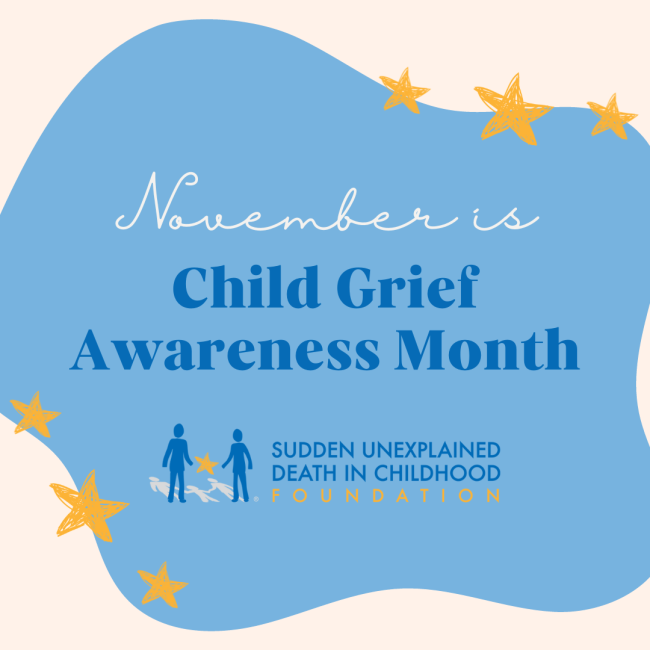01 Nov Understanding Children’s Grief: Navigating Sibling Loss

Written by: Amanda Brindle, LSW, Associate Manager of Family Services
November is Children’s Grief Awareness Month, a time to reflect on the unique challenges grieving children face. As part of the Sudden Unexplained Death in Childhood (SUDC) Foundation, we aim to shed light on the often-overlooked topic of how the loss of a child also effects the world of the surviving sibling(s).
Parent(s) overwhelmed by their own grief, may unintentionally struggle to fully support their surviving children. This dynamic creates a double loss for the grieving child, who mourns both their sibling and their grieving parent. It is helpful to incorporate our understanding of how children grieve into how we provide support to better assist them.
Children’s responses to loss vary based on their developmental stages, and recognizing these differences can be invaluable:
- Preschoolers (Ages 2-5): Young children in this age group may exhibit changes in behavior as they grapple with grief. They might experience regression, such as reverting to habits from an earlier age, or display heightened anxiety. For instance, a child who was previously potty-trained might start having accidents, or they could become more clingy and fearful. These behaviors are often ways for them to seek reassurance and regain a sense of security. Offering a consistent and loving presence is crucial during this time to help them feel safe and supported.
- Elementary School Children (Ages 6-12): This age group may show a diverse range of emotional responses to grief. Some children might express their feelings openly, while others may find it challenging to communicate their emotions. It’s not uncommon for them to switch between anger, sadness, and even moments of playfulness. Encouraging them to express their feelings through creative outlets like art, play, or talking can be beneficial. These activities can help them process their emotions and provide a means of self-expression, which can be particularly helpful in a period of grief where understanding and communicating feelings can be complex.
- Adolescents (Ages 13-18): Teenagers in this age group may experience grief in ways that are like adults. They often grapple with intense emotions, isolation, and may question their own identity and the world around them. Allowing them to have a voice and participate in decisions about memorial services, rituals, or any other aspects related to the loss can provide them with a sense of control. It acknowledges their growing autonomy and can be an essential part of their grieving process, helping them find their own path towards healing and understanding.
Understanding these varied responses to grief at different developmental stages allows us to provide tailored support and empathy to children as they navigate the challenging journey of grief. To effectively support them, it’s important to provide them with the tools and resources that are appropriate for their emotional and cognitive capabilities.
By acknowledging and addressing the unique needs of children in different age groups, we can offer the reassurance, stability, and healing they require during these challenging times. Here are some strategies in more detail to better understand how to help grieving children cope and find comfort in their grief journey.
Open and Honest Communication:
- Preschoolers (Ages 2-5): Young children at this stage may struggle to articulate their grief verbally. Encourage them to express themselves through drawings, toys, or play. Use simple, age-appropriate language to explain the loss. Be prepared for repetitive questions, as they may need reassurance.
- Elementary School Children (Ages 6-12): This age group often responds well to open conversations. Allow them to talk about their feelings and share their memories of their sibling. Answer their questions honestly and provide them with the space to express their emotions.
- Adolescents (Ages 13-18): Teens appreciate open discussions. Engage them in conversations about their sibling’s life, their own emotions, and the grieving process. Encourage them to express themselves through writing, art, or talking with a trusted adult. Be a good listener, offering a non-judgmental space for them to share their thoughts.
Consistency and Routine:
- Preschoolers (Ages 2-5): Young children often find comfort in routines. Maintain a consistent daily schedule, especially during turbulent times of grief. Ensure that meals, naps, and bedtime routines stay as predictable as possible.
- Elementary School Children (Ages 6-12): Help them adapt to changes by discussing any necessary adjustments to their routine. Provide them with a sense of control by allowing them to have a say in these changes.
- Adolescents (Ages 13-18): Adolescents can be more involved in shaping their routines. Encourage them to develop schedules that work for them while ensuring they maintain essential routines.
Seek Professional Help:
- Preschoolers (Ages 2-5): For young children, professional help might involve play therapy or art therapy. These therapies can help them express their feelings and cope with their grief in a developmentally appropriate way.
- Elementary School Children (Ages 6-12): This age group may benefit from child therapists who specialize in grief counseling. Therapists can teach them strategies for coping with their emotions and provide a safe space for discussing their grief.
- Adolescents (Ages 13-18): Seek out adolescent grief therapists who understand the unique challenges teenagers face. These professionals can help older children navigate complex emotions and develop healthy coping strategies.
Memorialize and Celebrate:
- Preschoolers (Ages 2-5): Involve them in age-appropriate memorial activities, such as creating simple drawings or placing flowers at a special spot. Use simple concrete language to explain the significance of these activities.
- Elementary School Children (Ages 6-12): Encourage them to participate in memorial services and rituals. They may also enjoy creating memorial projects, like scrapbooks or memory boxes, to celebrate their sibling’s life.
- Adolescents (Ages 13-18): Teens can take an active role in planning memorial events, deciding on rituals, and creating memorial projects. It’s important to involve them in the process and respect their ideas and choices.
By recognizing the developmental needs of grieving children, we can provide them with the support they require to navigate their grief in ways that are meaningful and appropriate for their age and understanding. Open and honest communication, consistency in routines, seeking professional help when necessary, and opportunities to memorialize and celebrate their sibling’s life all play vital roles in this journey.
As children grow, their understanding of death evolves, impacting how they cope. Younger children may exhibit immediate, visceral grief, while older ones engage in deeper introspection and question the circumstances of their sibling’s passing. Adapting support to meet these changing needs can provide much needed comfort and validation. This commitment to understanding and assisting grieving children throughout their journey is a compassionate and crucial step in their path to healing and recovery.


